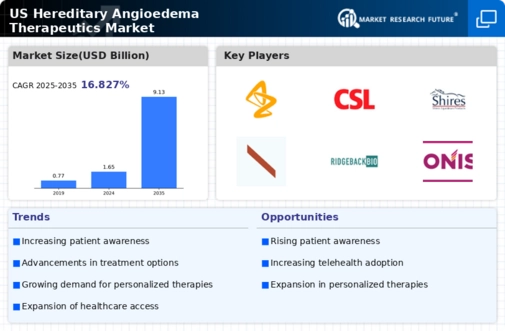The US Hereditary Angioedema Therapeutics Market has become increasingly competitive as pharmaceutical companies strive to address the unmet medical needs of patients suffering from this rare and potentially life-threatening condition. The market is characterized by a range of therapeutic options, including C1-esterase inhibitor therapies, bradykinin receptor antagonists, and other innovative treatments aimed at reducing the frequency and severity of angioedema attacks.
The rise in awareness of hereditary angioedema, improved diagnostic techniques, and ongoing research and development efforts contribute to a dynamic landscape where companies are competing for market share and striving to deliver effective solutions that enhance patient outcomes. Regulatory advancements also play a critical role in shaping the competitive environment, facilitating the approval and commercialization of new therapeutics.
AstraZeneca holds a notable presence in the US Hereditary Angioedema Therapeutics Market, leveraging its strong research and development capabilities to address this niche therapeutic area. The company's approach is supported by its robust pipeline and commitment to innovation, which enables it to explore novel therapeutic modalities.
AstraZeneca's established distribution channels and collaborations with leading healthcare providers reinforce its market position. The company utilizes a patient-centered strategy, focusing on increasing awareness and providing comprehensive support to patients and healthcare professionals, thereby fostering brand loyalty and enhancing treatment adherence.
Moreover, AstraZeneca's investment in clinical trials demonstrates its dedication to ensuring the efficacy and safety of its therapies, further solidifying its reputation in the industry.
Takeda Pharmaceutical is another key player in the US Hereditary Angioedema Therapeutics Market, recognized for its comprehensive range of treatment options that cater to the needs of patients with this condition. The company's key products include C1-esterase inhibitors and bradykinin receptor antagonists, which have been developed to significantly reduce the frequency of angioedema attacks and improve quality of life.
Takeda's commitment to research and development is highlighted by its ongoing investment in clinical trials and its focus on innovation within the hereditary angioedema therapeutic domain. Furthermore, Takeda's strategic mergers and acquisitions have bolstered its portfolio, enabling the company to enhance its market presence and expand its reach within the US region.
By combining its operational strengths with a deep understanding of patient needs, Takeda aims to provide effective solutions while fortifying its position in the rapidly evolving landscape of hereditary angioedema therapeutics.




















